Zika Virus Infection Induces DNA Damage Response in Human Neural Progenitors That Enhances Viral Replication
- PMID: 31375586
- PMCID: PMC6798117
- DOI: 10.1128/JVI.00638-19
Zika Virus Infection Induces DNA Damage Response in Human Neural Progenitors That Enhances Viral Replication
Abstract
Zika virus (ZIKV) infection attenuates the growth of human neural progenitor cells (hNPCs). As these hNPCs generate the cortical neurons during early brain development, the ZIKV-mediated growth retardation potentially contributes to the neurodevelopmental defects of the congenital Zika syndrome. Here, we investigate the mechanism by which ZIKV manipulates the cell cycle in hNPCs and the functional consequence of cell cycle perturbation on the replication of ZIKV and related flaviviruses. We demonstrate that ZIKV, but not dengue virus (DENV), induces DNA double-strand breaks (DSBs), triggering the DNA damage response through the ATM/Chk2 signaling pathway while suppressing the ATR/Chk1 signaling pathway. Furthermore, ZIKV infection impedes the progression of cells through S phase, thereby preventing the completion of host DNA replication. Recapitulation of the S-phase arrest state with inhibitors led to an increase in ZIKV replication, but not of West Nile virus or DENV. Our data identify ZIKV's ability to induce DSBs and suppress host DNA replication, which results in a cellular environment favorable for its replication.IMPORTANCE Clinically, Zika virus (ZIKV) infection can lead to developmental defects in the cortex of the fetal brain. How ZIKV triggers this event in developing neural cells is not well understood at a molecular level and likely requires many contributing factors. ZIKV efficiently infects human neural progenitor cells (hNPCs) and leads to growth arrest of these cells, which are critical for brain development. Here, we demonstrate that infection with ZIKV, but not dengue virus, disrupts the cell cycle of hNPCs by halting DNA replication during S phase and inducing DNA damage. We further show that ZIKV infection activates the ATM/Chk2 checkpoint but prevents the activation of another checkpoint, the ATR/Chk1 pathway. These results unravel an intriguing mechanism by which an RNA virus interrupts host DNA replication. Finally, by mimicking virus-induced S-phase arrest, we show that ZIKV manipulates the cell cycle to benefit viral replication.
Keywords: DNA damage; DNA damage checkpoints; DNA damage response; DNA replication; S phase; Zika virus; cell cycle; neural progenitors.
Copyright © 2019 American Society for Microbiology.
Figures
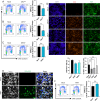

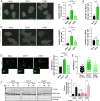
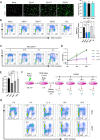
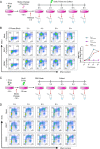
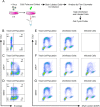

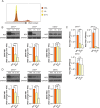

Similar articles
-
Zika Virus Induces Mitotic Catastrophe in Human Neural Progenitors by Triggering Unscheduled Mitotic Entry in the Presence of DNA Damage While Functionally Depleting Nuclear PNKP.J Virol. 2022 May 11;96(9):e0033322. doi: 10.1128/jvi.00333-22. Epub 2022 Apr 12. J Virol. 2022. PMID: 35412344 Free PMC article.
-
Zika Virus Infects Human Cortical Neural Progenitors and Attenuates Their Growth.Cell Stem Cell. 2016 May 5;18(5):587-90. doi: 10.1016/j.stem.2016.02.016. Epub 2016 Mar 4. Cell Stem Cell. 2016. PMID: 26952870 Free PMC article.
-
Molecular signatures associated with ZIKV exposure in human cortical neural progenitors.Nucleic Acids Res. 2016 Oct 14;44(18):8610-8620. doi: 10.1093/nar/gkw765. Epub 2016 Aug 31. Nucleic Acids Res. 2016. PMID: 27580721 Free PMC article.
-
Immune Response to Dengue and Zika.Annu Rev Immunol. 2018 Apr 26;36:279-308. doi: 10.1146/annurev-immunol-042617-053142. Epub 2018 Jan 18. Annu Rev Immunol. 2018. PMID: 29345964 Free PMC article. Review.
-
Zika infection and the development of neurological defects.Cell Microbiol. 2017 Jun;19(6). doi: 10.1111/cmi.12744. Epub 2017 May 3. Cell Microbiol. 2017. PMID: 28370966 Review.
Cited by
-
Zika virus induces FOXG1 nuclear displacement and downregulation in human neural progenitors.Stem Cell Reports. 2022 Jul 12;17(7):1683-1698. doi: 10.1016/j.stemcr.2022.05.008. Epub 2022 Jun 16. Stem Cell Reports. 2022. PMID: 35714598 Free PMC article.
-
Borna disease virus docks on neuronal DNA double-strand breaks to replicate and dampens neuronal activity.iScience. 2021 Dec 16;25(1):103621. doi: 10.1016/j.isci.2021.103621. eCollection 2022 Jan 21. iScience. 2021. PMID: 35024577 Free PMC article.
-
Zika virus infection differentially affects genome-wide transcription in neuronal cells and myeloid dendritic cells.PLoS One. 2020 Apr 14;15(4):e0231049. doi: 10.1371/journal.pone.0231049. eCollection 2020. PLoS One. 2020. PMID: 32287277 Free PMC article.
-
DNA damage and repair: underlying mechanisms leading to microcephaly.Front Cell Dev Biol. 2023 Oct 10;11:1268565. doi: 10.3389/fcell.2023.1268565. eCollection 2023. Front Cell Dev Biol. 2023. PMID: 37881689 Free PMC article. Review.
-
In Vitro Zika Virus Infection of Human Neural Progenitor Cells: Meta-Analysis of RNA-Seq Assays.Microorganisms. 2020 Feb 17;8(2):270. doi: 10.3390/microorganisms8020270. Microorganisms. 2020. PMID: 32079323 Free PMC article. Review.
References
-
- Qian X, Nguyen HN, Song MM, Hadiono C, Ogden SC, Hammack C, Yao B, Hamersky GR, Jacob F, Zhong C, Yoon KJ, Jeang W, Lin L, Li Y, Thakor J, Berg DA, Zhang C, Kang E, Chickering M, Nauen D, Ho CY, Wen Z, Christian KM, Shi PY, Maher BJ, Wu H, Jin P, Tang H, Song H, Ming GL. 2016. Brain-region-specific organoids using mini-bioreactors for modeling ZIKV exposure. Cell 165:1238–1254. doi:10.1016/j.cell.2016.04.032. - DOI - PMC - PubMed
Publication types
MeSH terms
Substances
Grants and funding
LinkOut - more resources
Full Text Sources
Medical
Research Materials
Miscellaneous

